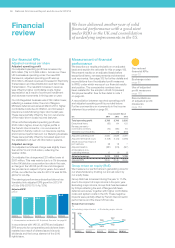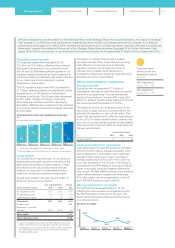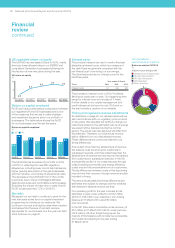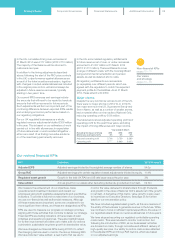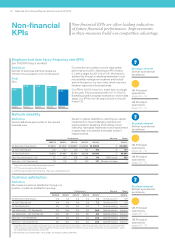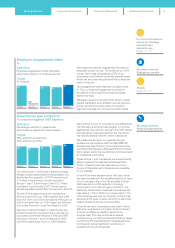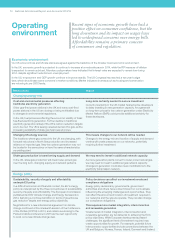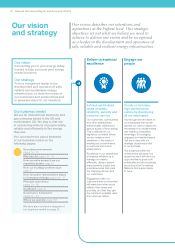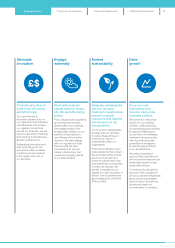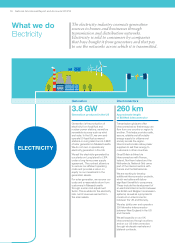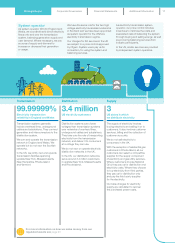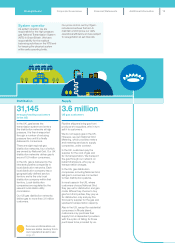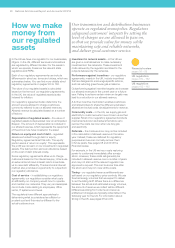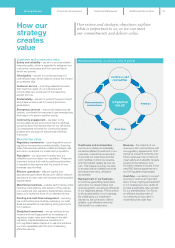National Grid 2014 Annual Report Download - page 15
Download and view the complete annual report
Please find page 15 of the 2014 National Grid annual report below. You can navigate through the pages in the report by either clicking on the pages listed below, or by using the keyword search tool below to find specific information within the annual report.
Strategic Report Corporate Governance Financial Statements Additional Information
Market driver Impact
UK policy changes are in place to attract investment
In the UK, energy policy continues to evolve from the Climate
Change Act 2008, which commits the UK Government to
reducing UK greenhouse gas emissions to at least 80% lower
than a 1990 baseline by 2050. The Energy Act 2013 implements
the main aspects of Electricity Market Reform (EMR), and puts
inplace measures to attract the investment needed to replace
current generating capacity and upgrade the grid by 2020,
andto cope with a rising demand for electricity.
National Grid has been asked to play a key delivery role
In the UK, National Grid has been asked to play a major role as
the delivery body for EMR, to be conferred on National Grid by
Government in secondary legislation.
US policy is evolving to meet environmental and energy
diversity goals
In the US, many federal level developments have been through
federal agency regulations and Presidential executive orders. At a
state level, energy policy continues to evolve in the northeastern
US, driven by interest in promoting energy efficiency, maintaining
reliability and deploying renewable technologies that help meet
environmental and energy diversity goals.
Options for increased renewable and distributed generation
are being explored
In the US, the impact on natural gas dependency has resulted
inan evaluation of the best way of increasing fuel diversity
through renewable and distributed generation resources.
Wecontinue to support movement towards a clean energy
economy; and support additional measures to increase
America’senergy productivity.
Regulation
Infrastructure investment needs must be balanced
with affordability
Regulators acknowledge that there is a significant need for
infrastructure investment. However, affordability continues
tobea primary concern.
Cast iron gas mains still in use can be more than 100 years old,
becoming riskier to use and contributing to greenhouse gas
emissions through leaks. Severe weather in recent years has
also highlighted the potential need for additional investment in
network resilience. Regulators and policymakers are beginning
to ask utilities to put plans in place to strengthen their networks’
ability to withstand the effects of severe weather.
We must accommodate customers’ cost concerns and also
provide safe, up-to-date systems
We must accommodate our customers’ affordability concerns
while fulfilling our obligations to provide safe and reliable services
and upgrading our systems. Investment is required for new
connections, to meet the challenges of changing supply and
demand patterns, and to replace ageing infrastructure in the
UKand US.
UK regulators want greater efficiency and innovation
In the UK, the regulatory focus during the year has been on the
new RIIO price controls which give greater focus to incentives
and innovation than the previous regulatory regime.
The projected increase in offshore wind generation and
interconnection has created a debate on the regulatory
approach to electricity transmission investment – a debate
wecontinue to be fully engaged in.
This is driving them to favour more market competition
In the UK, competition is already in place for offshore
development and Ofgem has stated its intent to retain the option
of using greater competition for certain large onshore projects.
For more information about network efficiency and innovation,
seepages 30, 31 and 33.
US policymakers are focused on grid modernisation
In the US, we are actively involved in the New York Energy
Highway initiative to examine new ways of delivering
infrastructure in the state. In Massachusetts, we are working
with regulators and policymakers on a new grid modernisation
policy. This is ongoing but is likely to affect our investments in
smart grid and metering, and cost recovery ofelectric
infrastructure investments.
This will present opportunities to address customers’ needs
more effectively
In the US, developments like the New York Energy Highway initiative,
the Reforming Energy Vision initiative announced by the Governor
ofNew York, the Massachusetts Grid Modernization regulatory
proceedingand our Connect21 dialogue with stakeholders, will
helppresent new opportunities to respond to customers’ needs
andbuild the necessary infrastructure to address them.
Innovation and technology
Technology developments have the potential to reshape
our market
There is continued significant technological development in the
energy sector as new technologies take shape and approach
commercial viability.
HVDC technology could play animportant part in the
development of a more integrated electricity grid, particularly
theextension of offshore links.
This influences demand and helps us to manage supply
While carbon-based generation is likely to remain a significant
part of the global energy mix, carbon capture and storage
technologies may become critical to governments achieving their
climate change targets. Technologies such as energy storage,
electric transportation and distributed generation all have the
potential to affect our networks significantly. New consumer
products, such as alternative fuelled vehicles and distributed
generation, will increase demand and require new infrastructure.
Smart grids will change the way loads are balanced across the
distribution network, allowing our customers to make smarter energy
choices and increasing network flexibility. Our infrastructure needs
the flexibility to respond innovatively to emerging developments,
potentially by being managed differently rather than by creating
new infrastructure to meet supply and demand changes.
13





